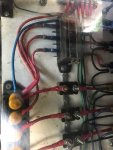Meili
Adventurer
The wiring on my S10 is a disaster, as I slowly do more projects to it they get fixed.
The CS130D(round) had a CS130(square) plug jammed into it, no fusible links, bad connections etc etc.
All that has been repaired. Took a while to get the charging system ironed out but I finally got it working well, picked up almost 2 volts!
That was until I wired in a basic 3 terminal battery isolator. Hard to screw that up.
If I disconnect the original charge wire from the alternator, it is hot/live, there is no output.
Seems like it "needs" voltage to the charge wire to excite?
I can run a switched 12v supply to the charge terminal. It will work but that defeats the purpose of the isolator, creating a loop when the key in on.
The alternator is now wired like the attached diagram using the correct plug:
S terminal (blue) to remote power block
I terminal (green) wired to switched 12v
P & L (white & yellow) are not used
Ideas?
The CS130D(round) had a CS130(square) plug jammed into it, no fusible links, bad connections etc etc.
All that has been repaired. Took a while to get the charging system ironed out but I finally got it working well, picked up almost 2 volts!
That was until I wired in a basic 3 terminal battery isolator. Hard to screw that up.
If I disconnect the original charge wire from the alternator, it is hot/live, there is no output.
Seems like it "needs" voltage to the charge wire to excite?
I can run a switched 12v supply to the charge terminal. It will work but that defeats the purpose of the isolator, creating a loop when the key in on.
The alternator is now wired like the attached diagram using the correct plug:
S terminal (blue) to remote power block
I terminal (green) wired to switched 12v
P & L (white & yellow) are not used
Ideas?
Attachments
Last edited:




